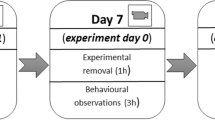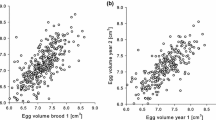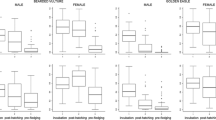Abstract
We recorded behaviour of kestrels (Falco tinnunculus) in western Finland during the courtship (1988–1992), incubation (1989–1991), early nestling (age of young 1–2 weeks, 1989–1992) and late nestling stages (3–4 weeks, 1989–1991) to examine determinants of their parental effort (PE). In males, PE was estimated as the hunting effort (the proportion of budget time spent in flight-hunting) and in females as the food provisioning rate (number of prey items delivered to the nest per hour). The following predictions derived from the parental investment theory were examined. (1) Parents rearing large clutches and broods should invest more in breeding than do parents rearing small clutches and broods. The hunting effort of parents did not increase with clutch or brood size, but males tending large broods had a higher prey delivery rate than males tending small broods (Figs 1–2). (2) PE of parents should increase in the course of the breeding season. In males, this was true only between the incubation and early nestling phases (Fig. 3). (3) The early pairs should invest more in breeding than late ones. This tended to be true during the early (for males) and late nestling phases (for females) (Fig. 4). (4) There should be a negative correlation between PE of mates within pairs, but no evidence for such adjustment was found (Fig. 5). (5) Females mated with bright-coloured attractive males should show higher PE than females mated with dull-coloured males but our results were inconsistent with this prediction. We conclude that PE decisions of kestrels are mainly based on cost-benefit estimates of residual reproductive value, rather than on current investment indicators, like clutch or brood size. This might be beneficial in environments with highly variable survival prospects of offspring caused by pronounced among-year variation in abundance of the main food (microtine rodents). The results also show that hypotheses explaining variation in PE in the short term are not necessarily valid for long-term PE, e.g. tending clutches or broods, which also reflects the demands of female and young.
Similar content being viewed by others
References
Altmann J (1974) Observational study of behavior: sampling methods. Behaviour 49:227–267
Andersson M, Wiklund CG, Rundgren H (1980) Parental defence of offspring: a model and an example. Anim Behav 28:536–542
Barash DP (1975) Evolutionary aspects of parental behaviour: distraction behaviour of the alpine accentor. Wilson Bull 87:367–373
Biebach H (1981) Energetic costs of incubation on different clutch sizes in starlings (Sturnus vulgaris). Ardea 69:141–142
Biermann GC, Sealy SG (1982) Parental feeding of nestling yellow warblers in relation to brood size and prey availability. Auk 99:332–341
Burley N (1988) The differential-allocation hypothesis: an experimental test. Am Nat 132:611–628
Cavé AJ (1968) The breeding of the kestrel, Falco tinnunculus L. in the reclaimed area Oostelijk Flevoland. Neth J Zool 18:313–407
Chase ID (1980) Cooperative and co-operative behaviour in animals. Am Nat 115:827–857
Clutton-Brock TH (1991) The evolution of parental care. Princeton University Press, Princeton
Coleman RM, Whittall RD (1988) Clutch size and the cost of incubation in the Bengalese finch (Lonchura striata var. domestica). Behav Ecol Sociobiol 23:367–372
Curio E, Regelmann K, Zimmerman U (1984) The defence of first and second broods by great tit (Parus major) parents: a test of predictive sociobiology. Z Tierpsychol 66:100–127
Dawkins R, Carlisle RT (1976) Parental investment, mate desertion and a fallacy. Nature 262:131–133
Dijkstra C, Vuursteen L, Daan S, Masman D (1982) Clutch size and laying date in the kestrel Falco tinnunculus: effects of supplementary food. Ibis 124:210–213
Fisher RA (1930) The genetical theory of natural selection. Oxford University Press, Oxford
Hakkarainen H, Korpimäki E (1994) Nest defence of Tengmalm's owl reflects offspring survival prospects under fluctuating food conditions. Anim Behav (in press)
Hansson L, Henttonen H (1985) Gradients in density variation of small rodents: the importance of latitude and snow cover. Oecologia 67:394–402
Houston AI, Davies NB (1985) The evolution of cooperation and life history in the dunnock Prunella modularis. In: Sibley RM, Smith RH (eds) Behavioural ecology. Blackwell Scientific, Oxford, pp 471–487
Hussel DJT (1972) Factors affecting clutch size in Arctic passerines. Ecol Monogr 42:317–364
Korpimäki E (1984) Population dynamics of birds of prey in relation to fluctuations in small mammal populations in western Finland. Ann Zool Fenn 21:287–293
Korpimäki E (1985) Diet of the kestrel Falco tinnunculus in the breeding season. Ornis Fenn 62:130–137
Korpimäki E (1986) Diet variation, hunting habitat and reproductive output of the kestrel Falco tinnunculus in the light of the optimal diet theory. Ornis Fenn 63:84–90
Korpimäki E (1988a) Factors promoting polygyny in European birds of prey — a hypothesis. Oecologia 77:278–285
Korpimäki E (1988b) Costs of reproduction and success of manipulated broods under varying food conditions in Tengmalm's owl. J Anim Ecol 61:103–111
Korpimäki E, Norrdahl K (1991) Numerical and functional responses of kestrels, short-eared owls, and long-eared owls to vole densities. Ecology 72:814–826
Lazarus J, Inglis IR (1986) Shared and unshared parental investment, parent-offspring conflict and brood size. Anim Behav 34:1791–1804
Masman D, Klaassen M (1987) Energy expenditure during free flight in trained and free-living Eurasian kestrels (Falco tinnunculus). Auk 104:603–616
Masman D, Gordijn M, Daan S, Dijkstra C (1986) Ecological energetics of the kestrel: field estimates of energy intake throughout the year. Ardea 74:24–39
Masman D, Dijkstra C, Daan S, Bult A (1989) Energetic limitation of avian parental effort: field experiments in the kestrel (Falco tinnunculus). J Evol Biol 2:435–455
Meijer T, Masman D, Daan S (1989) Energetics of reproduction in female kestrels. Auk 109:549–559
Montgomerie RD, Weatherhead PJ (1988) Risk and rewards of nest defence by parental birds. Q Rev Biol 63:167–187
Morehouse EL, Brewer R (1968) Feeding of nestling and fledgling in Eastern kingbirds. Auk 85:44–54
Moreno J, Gustaffson L, Carlson A, Part T (1991) The costs of incubation in relation to clutch size in the collared flycatcher Ficedula albicolis. Ibis 133:186–193
Morris DW (1987) Optimal allocation of parental investment. Oikos 49:332–339
Palokangas P, Alatalo RV, Korpimaki E (1992) Female choice in the kestrel under different availability of mating options. Anim Behav 43:659–665
Palokangas P, Korpimaki E, Hakkarainen H, Huhta E, Tolonen P, Alatalo RV (1994) Female kestrels gain reproductive success by choosing brightly ornamented males. Anim Behav 47:443–448
Royama T (1966) Factors governing feeding rate, food requirements and brood size of nestling great tits Parus major. Ibis 108:313–347
Sibly R, Calow P (1983) An integrated approach to life-history evolution using selective landscapes. J Theor Biol 102:527–547
Sokal RR, Rohlf FJ (1969) Biometry. Freeman, San Francisco
Tolonen P (1992a) Tuulihaukan (Falco tinnunculus L.) lisääntymispanostuksen ajallinen ja alueellinen vaihtelu. MS thesis, Department of Zoology, University of Oulu, Finland
Tolonen P (1992b) The kestrel nest defence: testing the parental investment theory. 4th International Behavioral Ecology Congress Abstracts, Princeton
Trivers RL (1972) Parental investment and sexual selection. In: Campbell B (ed) Sexual selection and the descent of man. Aldine, Chicago pp 136–179
Village A (1986) Breeding performance of kestrels at Eskdalemuir, south Scotland. J Zool Lond 208:367–378
Village A (1990) The kestrel. Poyser, Calton
Wallin K (1987) Defence as parental care in tawny owl (Strix aluco). Behaviour 102:213–230
Wallin K, Wallin M, Levin M, Jär»s T, Strandvik P (1987) Leapfrog migration in the Swedish kestrel Falco tinnunculus population. Acta Regiae Soc Sci Litt Gotho Zool 14:213–222
Walsh H (1978) Food of nestling purple martins. Wilson Bull 90:248–260
Weatherhead PJ (1979) Do savannah sparrows commit the Concorde fallacy? Behav Ecol Sociobiol 5:373–381
Wiklund CG (1990) The adaptive significance of nest defence by merlin, Falco columbarius, males. Anim Behav 40:244–253
Winkler DW (1987) A general model for parental care. Am Nat 130:526–543
Author information
Authors and Affiliations
Rights and permissions
About this article
Cite this article
Tolonen, P., Korpimäki, E. Determinants of parental effort: a behavioural study in the Eurasian kestrel, Falco tinnunculus . Behav Ecol Sociobiol 35, 355–362 (1994). https://doi.org/10.1007/BF00184424
Received:
Accepted:
Issue Date:
DOI: https://doi.org/10.1007/BF00184424




